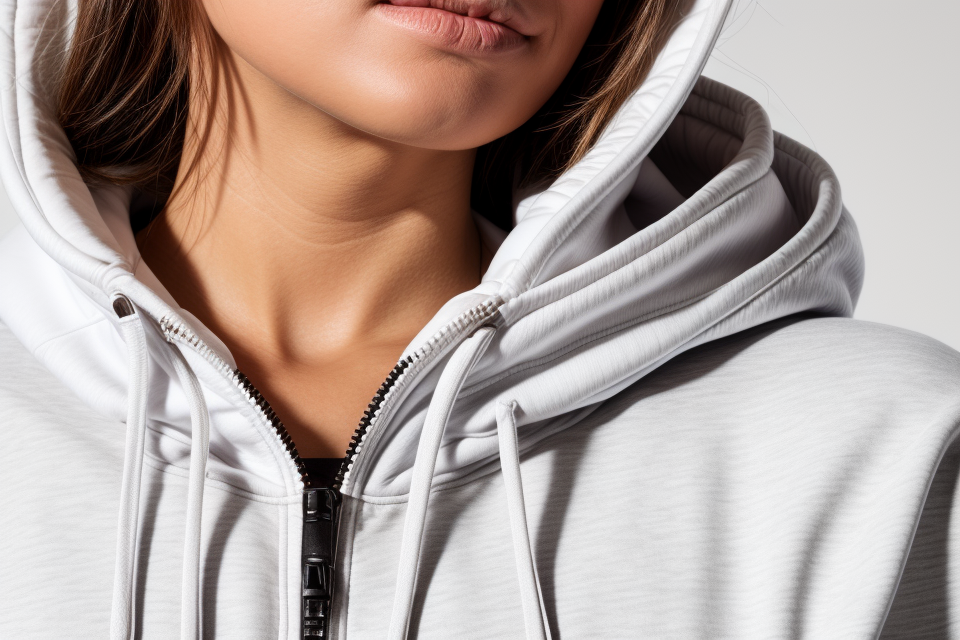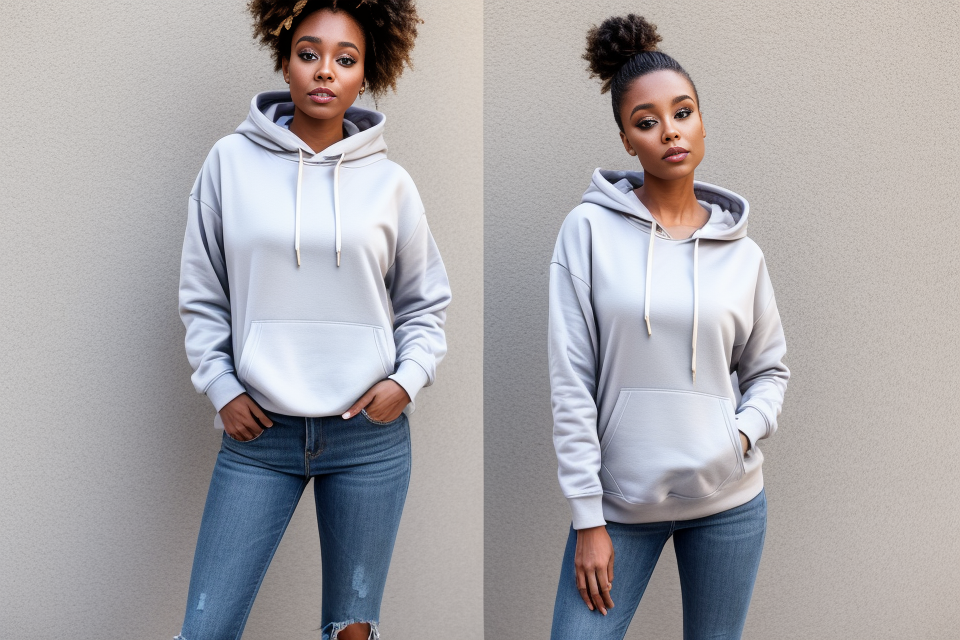
When it comes to casual wear, hoodies are undoubtedly one of the most popular choices. They are comfortable, stylish, and versatile, making them perfect for any occasion. But have you ever wondered what makes a hoodie comfortable? The answer lies in the material. From cotton to fleece, each material has its own unique set of properties that make it comfortable in its own way. In this article, we will explore the world of hoodies and delve into the most comfortable materials available. So, get ready to discover the secrets behind the ultimate comfort of your favorite hoodie!
When it comes to choosing the best material for a hoodie, there are several options to consider. The most popular materials for hoodies include cotton, polyester, fleece, and blends of these materials. Cotton is a natural material that is soft and comfortable, but it can be heavy and expensive. Polyester is a synthetic material that is lightweight and durable, but it can be less breathable than cotton. Fleece is a synthetic material that is warm and cozy, but it can be prone to pilling. Ultimately, the best material for a hoodie will depend on your personal preferences and the intended use of the hoodie. If you want a lightweight and breathable hoodie for casual wear, cotton or a cotton-polyester blend may be the best choice. If you want a warm and cozy hoodie for outdoor activities, a fleece or polyester hoodie may be the best choice.
The Importance of Material in Comfortable Hoodies
Factors Affecting Comfort
When it comes to comfortable hoodies, the material used plays a crucial role in determining how comfortable it will be to wear. There are several factors that affect the comfort of a hoodie, including its softness, breathability, durability, heat retention/insulation, and price.
- Softness: A hoodie’s softness is an important factor in its comfort. Soft materials are more comfortable to wear against the skin, and they also tend to be more flexible and easier to move in. Cotton and cotton blends are often considered the softest materials for hoodies, but other materials like bamboo and viscose can also be soft and comfortable.
- Breathability: Breathability is another important factor in a hoodie’s comfort. Materials that are breathable allow air to flow through them, which helps to regulate body temperature and prevent overheating. Moisture-wicking materials like polyester and nylon are often used in hoodies because they are highly breathable and can help to keep the wearer dry and comfortable.
- Durability: Durability is also an important factor in a hoodie’s comfort. A hoodie that is made from a durable material will last longer and withstand more wear and tear, which means it will be more comfortable to wear for a longer period of time. Heavy-duty materials like denim and canvas are often used in hoodies because they are durable and long-lasting.
- Heat retention/insulation: Heat retention and insulation are important factors in a hoodie’s comfort, especially during colder weather. Materials that are good at retaining heat, such as fleece and wool, can help to keep the wearer warm and comfortable in cold temperatures. On the other hand, materials that are good at insulating, such as down and synthetic insulation, can also help to keep the wearer warm and comfortable in cold weather.
- Price: Price is also an important factor in a hoodie’s comfort. Hoodies made from high-quality materials may be more expensive, but they are often more comfortable and longer-lasting than hoodies made from lower-quality materials. However, it is important to find a balance between price and quality, as spending too much money on a hoodie may not necessarily make it more comfortable.
Common Materials Used in Hoodies
When it comes to choosing the right material for a comfortable hoodie, there are several options to consider. Some of the most common materials used in hoodies include:
Cotton
Cotton is a popular choice for hoodies because it is soft, breathable, and comfortable to wear. It is also a natural material that is easy to care for, making it a practical choice for many people. However, cotton hoodies can be prone to shrinking if they are not washed and dried properly, so it is important to follow the care instructions carefully.
Polyester
Polyester is a synthetic material that is known for its durability and resistance to wrinkles. It is often used in hoodies because it is lightweight and comfortable to wear, and it can be machine washed and dried without shrinking. However, some people may find that polyester hoodies are less breathable than cotton or other materials, which can make them less comfortable to wear in warm weather.
Fleece
Fleece is a synthetic material that is known for its warmth and insulation. It is often used in hoodies because it can keep the wearer warm in cold weather, and it is also lightweight and comfortable to wear. However, fleece hoodies can be prone to pilling, which can create unsightly balls of fibers on the surface of the fabric.
Linen
Linen is a natural material that is known for its breathability and moisture-wicking properties. It is often used in hoodies because it can keep the wearer cool and comfortable in warm weather, and it is also lightweight and comfortable to wear. However, linen hoodies may require special care instructions, such as being washed in cold water and hung to dry, to prevent shrinking or damage to the fabric.
Tencel
Tencel is a synthetic material that is made from wood pulp. It is known for its softness, breathability, and moisture-wicking properties. It is often used in hoodies because it is lightweight and comfortable to wear, and it can be machine washed and dried without shrinking. However, tencel hoodies may be less durable than other materials, and they may require special care instructions to prevent damage to the fabric.
Cotton: The Classic Comfortable Choice
Pros
- Cotton is known for its soft and gentle texture on the skin, making it a popular choice for those who prioritize comfort.
- As a natural material, cotton is also environmentally friendly and biodegradable, which is a significant advantage for those who are conscious of their environmental impact.
- People with allergies often find cotton to be a suitable option, as it is a breathable fabric that does not irritate the skin.
- Cotton is an excellent material for absorbing moisture, making it ideal for active wear or for individuals who tend to sweat easily. Its moisture-wicking properties help to keep the wearer dry and comfortable.
Cons
- Limited warmth: Cotton hoodies are not as warm as other materials, such as fleece or synthetic blends. This makes them less suitable for colder weather or outdoor activities.
- Shrinkage and wrinkling: Cotton is prone to shrinkage when exposed to heat or rough washing, and it can also wrinkle easily. This may affect the hoodie’s fit and appearance over time.
- Cost: Cotton hoodies can be more expensive than other materials due to the higher production costs associated with cotton farming and processing. Additionally, high-quality cotton materials may result in a higher price point for the final product.
Polyester: A Versatile and Affordable Option
- Lightweight and easy to wear: Polyester is a lightweight fabric that is easy to wear, making it a popular choice for hoodies. The fabric is soft and comfortable against the skin, making it a great option for everyday wear.
- Quick-drying: One of the advantages of polyester is that it is a quick-drying fabric. This means that it can dry faster than other fabrics, making it a great option for active wear or for wearing in hot weather.
- Affordable: Polyester is an affordable fabric, making it a great option for those on a budget. It is also a versatile fabric that can be used for a variety of different applications, from casual wear to sportswear.
- Available in various textures: Polyester is available in a variety of textures, from smooth to fleecy. This means that you can choose the right texture for your needs, whether you want a smooth fabric for a more formal look or a fleecy fabric for added warmth.
- Lack of Softness: One of the main drawbacks of polyester is its lack of softness compared to cotton. The fabric can feel rough and harsh against the skin, which may not be ideal for those who prefer a more comfortable and gentle feel.
- Odor Retention: Another con of polyester is its tendency to retain odors. This can be particularly problematic for those who wear their hoodies for extended periods, as the fabric may start to smell unpleasant after a while.
- Reduced Breathability: Polyester is generally less breathable than cotton, which means that it can trap heat and moisture against the skin. This can make it uncomfortable to wear in hot weather or during intense physical activity, as it may cause you to feel overheated and sweaty.
Fleece: Warmth and Plushness Combined
Very warm and insulating
Fleece material is renowned for its ability to retain heat and keep the wearer warm in cold weather conditions. Its microfibers have tiny pockets of air that trap heat, making it an ideal choice for winter wear.
Soft and plush
Fleece fabric is known for its softness and plushness, which makes it extremely comfortable to wear. The material is lightweight and breathable, providing a luxurious feel against the skin.
Good for cold weather
As previously mentioned, fleece material is exceptional at retaining heat, making it an excellent choice for cold weather conditions. It can be worn as a standalone layer or as an inner layer under a jacket or coat.
Affordable
Fleece material is generally considered an affordable option when compared to other materials like cotton or synthetic blends. It is widely available and can be found in a variety of price ranges, making it accessible to a broad range of consumers.
- Can be heavy and bulky: One of the main drawbacks of fleece material is its tendency to be heavy and bulky. This can make it uncomfortable to wear during warmer months or for those who are constantly on the move. The weight of the fabric can also make it difficult to layer under other clothing.
- Can cause overheating: Another issue with fleece material is that it can cause overheating, especially if worn in hot weather or during strenuous activities. The insulating properties of fleece can trap heat, making it difficult to regulate body temperature.
- Not as breathable as other materials: Fleece material is not as breathable as other materials, such as cotton or synthetic blends. This can make it uncomfortable to wear for extended periods of time, as moisture can build up and cause the fabric to feel clammy. Additionally, the lack of breathability can make it difficult to stay cool when the weather heats up.
Linen: A Breathable and Comfortable Choice
- Breathable and lightweight
Linen is renowned for its natural ability to allow air to flow through the fabric, which results in a breathable and lightweight material that keeps the wearer cool in warm weather. - Moisture-wicking
Linen’s moisture-wicking properties enable it to draw sweat away from the body, ensuring that the wearer stays dry and comfortable. - Cooling in hot weather
Due to its natural composition, linen has a natural insulation that keeps the body cool in hot weather. This is especially beneficial for individuals who live in warmer climates or engage in outdoor activities. - Long-lasting
Linen is a durable fabric that can withstand regular wear and tear. It is resistant to tears and has a natural elasticity that allows it to bounce back into shape after being washed. Additionally, linen becomes softer and more comfortable with each wash, making it a great investment for those who value quality and longevity in their clothing. - Requires careful washing and maintenance
- Can be prone to wrinkles
- Not as warm as other materials
While linen is a popular choice for hoodies due to its breathability and comfort, it also has some downsides to consider. One of the main cons of linen is that it requires careful washing and maintenance. This is because linen is prone to shrinking, wrinkling, and wrinkling, which can affect the fit and appearance of the hoodie. To avoid these issues, it is important to follow the washing instructions carefully and to avoid using harsh detergents or fabric softeners.
Another con of linen is that it can be prone to wrinkles. This is because linen is a natural fiber that is prone to absorb moisture, which can cause it to wrinkle. While this can add a bit of texture and character to the hoodie, it can also make it look unkempt or disheveled. To minimize wrinkles, it is important to iron the hoodie promptly and to avoid exposing it to moisture or heat.
Finally, linen is not as warm as other materials. This is because it is a lightweight and breathable fabric that is not well-suited to insulation. While this can make it a good choice for warmer weather or for layering under other clothing, it may not be as suitable for colder conditions. If you are looking for a hoodie that is warm and cozy, you may want to consider other materials such as fleece or wool.
Tencel: A Sustainable and High-Tech Choice
Soft and Smooth Texture
Tencel is known for its soft and smooth texture, making it a popular choice for hoodies. The material is made from eucalyptus trees, which are renowned for their softness and durability. This makes Tencel hoodies comfortable to wear, with a smooth and luxurious feel that is difficult to find in other materials.
Eco-friendly and Sustainable
One of the biggest advantages of Tencel is its eco-friendliness and sustainability. The material is made from wood pulp sourced from sustainably managed forests, which helps to reduce the environmental impact of hoodie production. In addition, Tencel is biodegradable and compostable, making it a more sustainable choice than other materials.
Moisture-wicking and Breathable
Tencel is also known for its moisture-wicking and breathable properties. The material is able to wick moisture away from the body, keeping the wearer cool and comfortable. This makes Tencel hoodies ideal for active wear, as they are able to regulate body temperature and keep the wearer dry and comfortable.
Anti-static and Odor-resistant
Another benefit of Tencel is its anti-static and odor-resistant properties. The material is naturally resistant to static electricity, which can be a problem in other materials. In addition, Tencel is able to resist odors, making it a great choice for people who are active or workout regularly. This helps to keep hoodies fresh and clean, even after multiple wears.
- One of the main drawbacks of Tencel is that it is more expensive than other materials such as cotton or polyester. This may make it less accessible to budget-conscious consumers or those who are looking for a more affordable option.
- Another potential downside of Tencel is that it may be harder to find in stores compared to other materials. As Tencel is a newer and less widely used material, it may not be as readily available in most retail outlets.
- Additionally, Tencel can wrinkle easily, which may require more ironing or maintenance to keep it looking its best. This may be a consideration for those who prefer hoodies that require less upkeep or are more resistant to wrinkles.
Making the Right Choice: Factors to Consider
When it comes to choosing the right hoodie material, there are several factors to consider. Here are some key factors to keep in mind when making your decision:
Activity Level
The level of physical activity you engage in will impact the type of hoodie material that is best for you. If you lead an active lifestyle, you may want to consider materials that are lightweight, moisture-wicking, and quick-drying. This will help you stay comfortable and dry during intense workouts or outdoor activities.
Climate
Your location and the climate you live in will also play a role in determining the best hoodie material for you. For example, if you live in a cold climate, you may want to opt for a hoodie made from a warm and insulating material such as fleece or wool. On the other hand, if you live in a warmer climate, you may prefer a lightweight and breathable material like cotton or synthetic blends.
Personal Preferences
Your personal preferences and lifestyle habits will also influence your choice of hoodie material. For example, if you prefer a casual and relaxed look, you may prefer a hoodie made from a soft and comfortable fabric like cotton or jersey. If you prioritize functionality and performance, you may opt for a hoodie made from a technical fabric that offers superior moisture-wicking and quick-drying properties.
Budget
Finally, your budget will also play a role in determining the best hoodie material for you. Different materials have different price points, and you’ll want to choose a material that fits within your budget while still meeting your needs. Consider factors like durability, longevity, and potential maintenance requirements when making your decision.
FAQs
1. What are hoodies made of?
Hoodies are typically made of a variety of materials, including cotton, polyester, fleece, and blends of these materials. Some hoodies may also be made of synthetic materials like nylon or spandex.
2. What are the most common materials used for hoodies?
The most common materials used for hoodies are cotton and polyester. Cotton hoodies are soft and comfortable, while polyester hoodies are lightweight and durable. Fleece hoodies are also a popular choice due to their warmth and softness.
3. What are the pros and cons of different materials for hoodies?
Cotton hoodies are soft and comfortable, but they can be heavy and may not breathe as well as other materials. Polyester hoodies are lightweight and durable, but they may not be as soft as cotton hoodies. Fleece hoodies are warm and soft, but they may not be as durable as polyester hoodies.
4. How do I choose the right material for my hoodie?
The right material for your hoodie will depend on your personal preferences and the intended use of the hoodie. If you want a hoodie for warmth, a fleece hoodie may be the best choice. If you want a hoodie for everyday wear, a cotton or polyester hoodie may be a good choice.
5. Can I wash my hoodie in the washing machine?
Yes, most hoodies can be washed in the washing machine. However, some materials may require special care, such as washing in cold water or avoiding the use of bleach. It’s always a good idea to check the care label on your hoodie before washing it.


